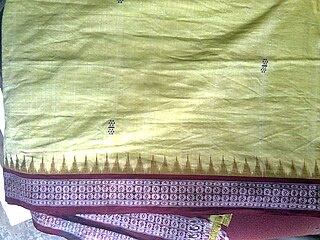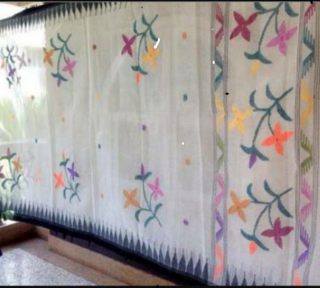Related Research Articles

A loom is a device used to weave cloth and tapestry. The basic purpose of any loom is to hold the warp threads under tension to facilitate the interweaving of the weft threads. The precise shape of the loom and its mechanics may vary, but the basic function is the same.

Weaving is a method of textile production in which two distinct sets of yarns or threads are interlaced at right angles to form a fabric or cloth. Other methods are knitting, crocheting, felting, and braiding or plaiting. The longitudinal threads are called the warp and the lateral threads are the weft, woof, or filling. The method in which these threads are interwoven affects the characteristics of the cloth. Cloth is usually woven on a loom, a device that holds the warp threads in place while filling threads are woven through them. A fabric band that meets this definition of cloth can also be made using other methods, including tablet weaving, back strap loom, or other techniques that can be done without looms.
Ikat is a dyeing technique originating from Indonesia used to pattern textiles that employs resist dyeing on the yarns prior to dyeing and weaving the fabric.

Warp and weft are the two basic components used in weaving to turn thread or yarn into fabric. The lengthwise or longitudinal warp yarns are held stationary in tension on a frame or loom while the transverse weft is drawn through and inserted over and under the warp. A single thread of the weft crossing the warp is called a pick. Terms vary. Each individual warp thread in a fabric is called a warp end or end.

Jamdani is a fine muslin textile produced for centuries in South Rupshi of Narayanganj district on the bank of Shitalakhwa river in what was Bengal and eventually became Bangladesh - see Partition of India.

Textile Manufacturing or Textile Engineering is a major industry. It is largely based on the conversion of fibre into yarn, then yarn into fabric. These are then dyed or printed, fabricated into cloth which is then converted into useful goods such as clothing, household items, upholstery and various industrial products.

Paithani is a variety of sari, named after the Paithan town in Aurangabad district from state of Maharashtra in India where the sari was first made by hand. Present day Yeola town in Nashik, Maharashtra is the largest manufacturer of Paithani.

Kasuri (絣) is the Japanese term for fabric that has been woven with fibers dyed specifically to create patterns and images in the fabric, typically referring to fabrics produced within Japan using this technique. It is a form of ikat dyeing, traditionally resulting in patterns characterized by their blurred or brushed appearance.

A selvage or selvedge is a "self-finished" edge of a piece of fabric which keeps it from unraveling and fraying. The term "self-finished" means that the edge does not require additional finishing work, such as hem or bias tape, to prevent fraying.
The manufacture of textiles is one of the oldest of human technologies. To make textiles, the first requirement is a source of fiber from which a yarn can be made, primarily by spinning. The yarn is processed by knitting or weaving, which turns yarn into cloth. The machine used for weaving is the loom. For decoration, the process of colouring yarn or the finished material is dyeing. For more information of the various steps, see textile manufacturing.
Textile manufacturing is one of the oldest human activities. The oldest known textiles date back to about 5000 B.C. In order to make textiles, the first requirement is a source of fibre from which a yarn can be made, primarily by spinning. The yarn is processed by knitting or weaving to create cloth. The machine used for weaving is the loom. Cloth is finished by what are described as wet process to become fabric. The fabric may be dyed, printed or decorated by embroidering with coloured yarns.

A Sambalpuri sari is a traditional handwoven bandha (ikat) sari wherein the warp and the weft are tie-dyed before weaving. It is produced in the Sambalpur, Balangir, Bargarh, Boudh and Sonepur districts of Odisha, India. The sari is a traditional female garment in the Indian subcontinent consisting of a strip of unstitched cloth ranging from four to nine metres in length that is draped over the body in various styles.

Siripuram is a village and a gram panchayat of Ramannapet Mandal, Nalgonda District, in Telangana state.

Bomkai sari or Bomkai Saree is a handloom saree from Odisha, India. It is an origin of Bomkai village from Ganjam district, however later it is mainly produced by the Bhulia community of Subarnapur district. Bomkai is one of the identified Geographical Indications of India. Bomkai Sarees are popular items displayed at various fashion shows.
Venkatagiri Sari is a sari style woven in Venkatagiri of Tirupati district in the Indian state of Andhra Pradesh. It was registered as one of the geographical indication from Andhra Pradesh by Geographical Indications of Goods Act, 1999. Venkatagiri saris are known for their fine weaving. These style of saris can also be found in the villages of Sengunthapuram, Variyankaval, Elaiyur, Kallathur, Andimadam and Marudhur villages.
Mangalagiri Sarees and Fabrics are produced by performing handicraft weaving in Mangalagiri, a town in Guntur district of the Indian state of Andhra Pradesh. It was registered as one of the handicraft in the geographical indication from Andhra Pradesh by Geographical Indications of Goods Act, 1999. The Mangalagiri fabric is produced by weaving with the help of pitlooms from combed yarn by warp and woof interlacing. The fabric then undergoes the process of dyeing. The Nizam design is another characteristic of the fabric.

Odisha Ikat, is a kind of ikat known as Bandhakala and Bandha, a resist dyeing technique, originating from Indian state of Odisha. Traditionally known as "Bandhakala"', "Bandha", '"Bandha of Odisha", it is a geographically tagged product of Odisha since 2007. It is made through a process of tie-dying the warp and weft threads to create the design on the loom prior to weaving. It is unlike any other ikat woven in the rest of the country because of its design process, which has been called "poetry on the loom". This design is in vogue only at the western and eastern regions of Odisha; similar designs are produced by community groups called the Bhulia, Kostha Asani, and Patara. The fabric gives a striking curvilinear appearance. Saris made out of this fabric feature bands of brocade in the borders and also at the ends, called anchal or pallu. Its forms are purposefully feathered, giving the edges a "hazy and fragile" appearance. There are different kinds of bandha saris made in Odisha, notably Khandua, Sambalpuri, Pasapali, Kataki and Manibandhi.

Gopalpur is a village known for producing Tussar fabrics. It is in Jajpur District in the Indian state of Odisha. This handicraft received the Geographical Indication tag by the Government of India in 2009. Tussar textiles are related to dhoti, joda, Shawl stole, scarves and saris.

Wangkhei Phee is a textile fabric made of white cotton. It is a product which is protected under the GI registration and is made throughout the Indian state of Manipur and is woven by women. The fabric is transparent, has many designs on its body, and is popularly worn by women of Manipur for marriage ceremonies and other festive occasions.
Shaphee Lanphee is a traditional textile fabric woven and embroidered, usually as a shawl, with embroidered motifs with cotton threads generally by Meitei women of Manipur. The fabric was, in the past, presented as a gift of honour to the soldiers for their bravery in a successful war, and to the praise-worthy chiefs of the Nagas of Manipur by the king of Manipur. It is a product which is protected under the GI registration and is now made throughout the Indian state of Manipur.
References
- 1 2 3 4 5 6 7 8 "Moirang Phee" (PDF). Government of India. 29 November 2013. Archived from the original (pdf) on 2 August 2014. Retrieved 15 May 2016.
- 1 2 "Moirang Phee:Geographical Indication Registry" (pdf). Government of Manipur. Retrieved 7 May 2016.[ permanent dead link ]
- ↑ "GI registration for Shaphee Lanphee, Moirang phee, Wangkhei Phee officially handed over to the state". Manipur Times. 30 May 2014. Retrieved 7 May 2016.